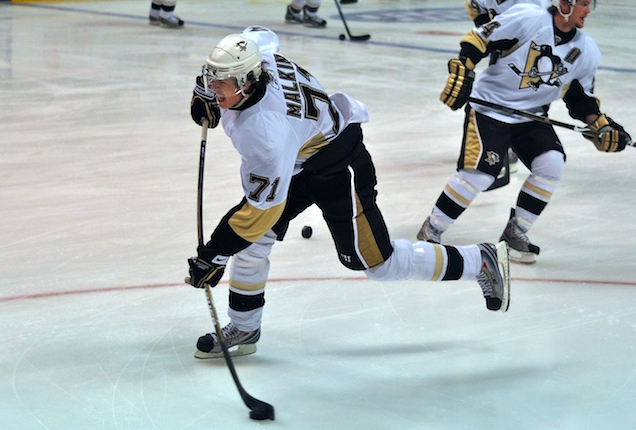
Evgeni Malkin – Pittsburgh Penguins (Flickr/FrenchKheldar)
After scoring 50 goals last year, and spending the lockout tearing up the KHL, it looked like Evgeni Malkin was poised to set the NHL on fire yet again. However, things haven't exactly gone as planned. Through 15 games, Malkin has only three goals, and only one of those came at even strength.
Those are hardly the numbers you'd expect from a player of his caliber, but watching him play it's hard to put your finger on a reason why he's not producing. He's still getting plenty of ice time, skating well, shooting the puck a lot, and getting good chances. Malkin, for some reason, just isn't converting.
So what gives?
New Role on the Power Play
The first reason that Malkin's goal totals are down is that he's playing a new role on the power play. After letting Steve Sullivan walk in the offseason, the Penguins have been grasping for a replacement on the power play point. Dan Bylsma originally tried to use James Neal in that position to no avail and ended up turning to Malkin to fill the role. And despite his defensive deficiencies, Malkin has actually performed quite well. He just isn’t putting the puck in the net himself.
Malkin may have only scored two goals so far, but he is averaging almost two more power play points/60 minutes than he did last year. And I don’t know if you can reasonably expect his power play goal numbers to rise. As long as Malkin is serving as the power play quarterback, his job is to set the play up and create beautiful highlight reel goals like this one, not to pull the trigger:
What's more is that it looks like the gamble is paying off for the team as a whole. In his first outing on the power play point, it looked like Malkin was going to be a huge liability defensively, but he has since tightened up. The Penguins are still allowing an abnormally high amount of shorthanded goals (2nd most per 60 minutes in the NHL), but as it turns out, they're scoring more than enough to make up for it. Their team 5v4 +-/60 of 8.6 ranks 5th best in the league.
However none of this explains anything at all about why Malkin isn't producing at even strength.
Linemate Woes

Despite landing a choice assignment skating with Evgeni Malkin and James Neal, Zach Boychuk (pictured) failed to score a single point in eight games (Charles LeClaire-USA TODAY Sports)
The most common explanation for Malkin's even strength woes is that he doesn't have adequate help on his line. Last season, Malkin took the majority of his even strength shifts with James Neal and Chris Kunitz. Neal is still there, and is having a stellar season. But Kunitz has been promoted to Sidney Crosby's line, leaving a rotating vortex of suck on the other wing. Eric Tangradi failed to produce anything at all, paving the way toward his departure from the team. And waiver-wire-pickup-turned-healthy-scratch Zach Boychuk didn't fare any better (0 goals, 0 assists in 8 games).
Now the Penguins have turned to Matt Cooke and rookie Beau Bennett who both took shifts on the Malkin line last night against Winnipeg. It's still too early to say whether either one of them will succeed in that spot ' and for what it's worth, Bennett looks very skilled ' but they will likely be on a short leash, as Ray Shero is already reportedly looking to bring someone else in.
#penguins GM Ray Shero is in Minnesota scouting tonight’s #mnwild #avalanche game. Pens looking for top-6 winger
' Michael Russo (@Russostrib) February 15, 2013
But I don't think that's the only problem, and I have numbers to back me up.
Bad Luck: PDO and Shooting Percentage
As anyone familiar with advanced stats will tell you, PDO ' a quantitative measure of a player's 'luck' – is one of the most useful tools out there. And Malkin's luck (PDO: 96.3) is pretty crappy. Only Tyler Kennedy (95.2) and Malkin-linemates James Neal (93.9) and Zack Boychuk (92.8) have had worse luck than Geno.
So how does PDO work? I've explained this stat before in some of my other articles, but I think it bears explaining again. Since team shooting percentage and team save percentage are largely luck driven, adding those two stats together for the time a certain player is on the ice allows us to see whether or not the 'bounces' have been going his way.
Here's the definition from Hockey Prospectus:
'Created by Vic Ferrari, PDO is the sum of a player’s on-ice save percentage and on-ice shooting percentage. PDO is an excellent way to measure “puck luck” or good fortune as it regresses heavily to the mean of 100 (sometimes shown as 1000). For example, a player with a PDO of 103.4 is likely to see his luck drop next year, affecting his plus-minus or point totals. A player with a PDO of 97.1 will likely have a “bounceback” year purely by getting a few more bounces go his way.'
Winnipeg Jets and advanced stats blog-extraordinaire Arctic Ice Hockey provides another very good explanation here, if you are still confused.
Simply put, luck evens out in the end. With a PDO of 96.3, it's only a matter of time before the bounces start going Malkin's way, and when they do, his production will skyrocket.
A look at Malkin's shooting percentage tells the same story. According to Behind the Net, which factors in shots, missed shots and shots blocked, Malkin is converting on a paltry 2.2% of his even strength attempts right now ' the lowest on the team and lowest of his career. To put that in context, he converted on 13.7% last year and has a career average of 9.3%. He is missing the net more often than usual (0.32 misses/attempt this year compared to 0.25 misses/attempt for his career), but not enough to have such a large effect on his shooting percentage.
Take a look at these highlights. More often than not, these shots go in.
The bounces will come with due time. Malkin, Bylsma, Ray Shero and Penguins fans just have to be patient.
Author information
This article was originally published at: The Hockey Writers.
0 komentar:
Posting Komentar